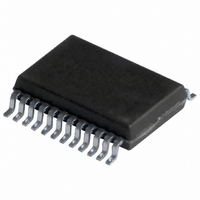PCF8575CTS/1,112 NXP Semiconductors, PCF8575CTS/1,112 Datasheet - Page 9

PCF8575CTS/1,112
Manufacturer Part Number
PCF8575CTS/1,112
Description
IC I/O EXPANDER I2C 16B 24SSOP
Manufacturer
NXP Semiconductors
Datasheet
1.PCF8575CTS1112.pdf
(24 pages)
Specifications of PCF8575CTS/1,112
Interface
I²C
Number Of I /o
16
Interrupt Output
Yes
Frequency - Clock
400kHz
Voltage - Supply
4.5 V ~ 5.5 V
Operating Temperature
-40°C ~ 85°C
Mounting Type
Surface Mount
Package / Case
24-SSOP
Includes
POR
Lead Free Status / RoHS Status
Lead free / RoHS Compliant
Other names
568-3528-5
935278677112
PCF8575CTSDB
935278677112
PCF8575CTSDB
Philips Semiconductors
6.3
All ports programmed as input should be set to logic 1.
To read, the master (microcontroller) first addresses the
slave device after it receives the interrupt. By setting the
last bit of the byte containing the slave address to logic 1
the read mode is entered. The data bytes that follow on the
SDA are the values on the ports.
If the data on the input port changes faster than the master
can read, this data may be lost.
6.4
To write, the master (microcontroller) first addresses the
slave device. By setting the last bit of the byte containing
the slave address to logic 0 the write mode is entered. The
PCF8575C acknowledges and the master sends the first
data byte for P07 to P00. After the first data byte is
acknowledged by the PCF8575C, the second data byte
P17 to P10 is sent by the master. Once again the
PCF8575C acknowledges the receipt of the data after
which this 16-bit data is presented on the port lines.
The number of data bytes that can be sent successively is
not limited. After every two bytes the previous data is
overwritten.
The first data byte in every pair refers to Port 0
(P07 to P00), whereas the second data byte in every pair
refers to Port 1 (P17 to P10), see Fig.7.
1999 Aug 05
handbook, full pagewidth
Remote 16-bit I/O expander for I
Reading from a port (input mode)
Writing to the port (output mode)
P07 P06 P05 P04 P03 P02 P01 P00
07
06
05
04
First Byte
Fig.7 Correlation between bits and ports.
03
02
01
2
C-bus
00
A
9
P17 P16 P15 P14 P13 P12 P11 P10
17
6.5
The PCF8575C provides an open-drain interrupt (INT)
which can be fed to a corresponding input of the
microcontroller (see Figs 5, 6 and 8). This gives these
chips a kind of a master function which can initiate an
action elsewhere in the system.
An interrupt is generated by any rising or falling edge of the
port inputs. After time t
The interrupt disappears when data on the port is changed
to the original setting or data is read from or written to the
device which has generated the interrupt.
In the write mode the interrupt may become deactivated
(HIGH) on the rising edge of the write to port pulse. On the
falling edge of the write to port pulse the interrupt is
definitely deactivated (HIGH).
The interrupt is reset in the read mode on the rising edge
of the read from port pulse.
During the resetting of the interrupt itself any changes on
the I/Os may not generate an interrupt. After the interrupt
is reset any change in I/Os will be detected and transmitted
as an INT.
16
Interrupt
15
14
Second Byte
13
12
iv
11
the signal INT is valid.
10
MGL545
A
Product specification
PCF8575C















